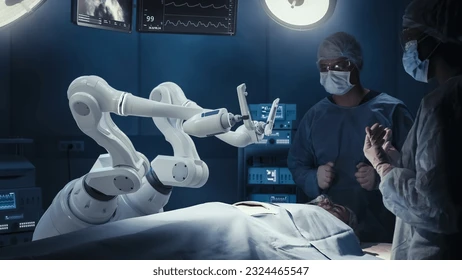The integration of robotics in surgical procedures has transformed healthcare by improving precision, reducing invasiveness, and enhancing patient recovery. Traditional surgeries often face challenges such as human fatigue, limited dexterity, and the risk of complications. Robotic-assisted systems offer unprecedented accuracy, real-time imaging, and minimally invasive techniques that reduce surgical risks and recovery time. Advances in artificial intelligence (AI), machine learning, and real-time data analytics have further expanded the capabilities of surgical robots, paving the way for more efficient and safer procedures.
Key Technological Advances in Robotic Surgery
1. AI-Driven Robotic-Assisted Surgery
- AI algorithms enhance robotic precision by analyzing patient-specific anatomical data.
- Machine learning models predict potential complications, assisting surgeons in decision-making.
- AI-based automation reduces surgical errors by improving control over robotic arms.
2. Minimally Invasive Robotic Systems
- Micro-robots and flexible robotic arms enable surgeries with smaller incisions.
- Enhanced dexterity allows for precise manipulation in complex procedures.
- Patients experience less pain, shorter hospital stays, and quicker recovery.
3. Real-Time Imaging and Navigation Systems
- High-definition 3D imaging provides surgeons with a detailed view of internal organs.
- Augmented reality (AR) overlays allow real-time guidance during complex surgeries.
- AI-powered imaging systems adapt to patient movements for greater accuracy.
4. Tactile Feedback and Haptic Technology
- Advanced robotic systems provide real-time force feedback to surgeons.
- Haptic technology enhances control, making robotic surgery feel more intuitive.
- Surgeons can perform delicate procedures with greater sensitivity and control.
5. Remote Surgery and Telesurgery
- Robotic-assisted telesurgery enables procedures to be performed from distant locations.
- High-speed 5G networks and AI reduce latency, ensuring precise movements.
- Remote surgery expands healthcare access to underserved regions.
Applications of Robotics in Precision Surgery
1. Neurosurgery: Enhancing Accuracy in Brain Procedures
- Robotic systems assist in delicate brain surgeries, reducing the risk of damage to critical structures.
- AI-driven imaging improves tumor localization and precision in excisions.
- Minimally invasive robotic techniques reduce post-operative complications.
2. Orthopedic Surgery: Precision in Joint Replacements
- Robotic-assisted systems improve implant positioning in knee and hip replacements.
- AI-driven planning enhances patient-specific surgical approaches.
- Minimally invasive orthopedic robotic procedures reduce rehabilitation time.
3. Cardiovascular Surgery: Improving Outcomes in Heart Procedures
- Robotic-assisted heart surgery allows for precise suturing in valve repairs.
- Minimally invasive coronary artery bypass procedures reduce patient recovery time.
- AI-powered robotics help in catheter-based interventions for treating heart diseases.
4. Urological Surgery: Advancements in Prostate and Kidney Procedures
- Robotic-assisted prostatectomy improves cancer treatment with minimal side effects.
- Precision in robotic kidney surgeries reduces damage to surrounding tissues.
- AI-driven imaging helps surgeons in targeted tumor removals.
5. Gynecological and Reproductive Surgeries
- Robotic-assisted hysterectomy and myomectomy improve surgical accuracy.
- Minimally invasive procedures reduce risks in reproductive surgeries.
- AI-powered robotic systems enhance fertility treatments and reproductive health procedures.
6. General Surgery: Expanding Robotics Beyond Specialized Fields
- Robotic-assisted laparoscopic surgeries reduce the risks associated with open procedures.
- AI-driven endoscopic robotics improve gastrointestinal surgeries.
- Precision robotic techniques minimize scarring and post-operative discomfort.
Benefits of Robotics in Precision Surgery
1. Increased Surgical Precision and Accuracy
- AI-powered robotic arms execute movements with sub-millimeter accuracy.
- Real-time imaging enhances precision in complex procedures.
2. Reduced Surgical Invasiveness
- Smaller incisions lead to lower infection risks and faster recovery.
- Minimal damage to surrounding tissues reduces post-operative complications.
3. Shorter Recovery Times and Hospital Stays
- Less trauma to the body leads to quicker patient rehabilitation.
- Reduced hospital stays lower healthcare costs for patients and providers.
4. Enhanced Surgeon Capabilities and Reduced Fatigue
- Robotic systems minimize human hand tremors, ensuring steady surgical movements.
- AI-driven automation assists in repetitive tasks, allowing surgeons to focus on critical aspects.
5. Expanding Access to Specialized Surgeries
- Remote robotic surgeries provide expert care in rural and underserved regions.
- AI-powered telesurgery enhances global surgical collaboration.
Challenges and Future Prospects in Robotic Surgery
1. High Costs and Accessibility Issues
- Robotic surgical systems require significant investment in equipment and training.
- High costs may limit widespread adoption, especially in developing regions.
2. Need for Advanced Training and Surgeon Adaptation
- Surgeons must undergo extensive training to master robotic-assisted procedures.
- Integrating robotics into traditional surgical workflows requires time and adaptation.
3. Regulatory and Ethical Considerations
- Ensuring patient safety and data security in AI-driven robotic surgeries is critical.
- Ethical concerns about automation replacing human decision-making need to be addressed.
4. Technological Advancements and AI Integration
- Future developments in AI will further enhance robotic surgery capabilities.
- Improved robotic autonomy may lead to fully automated surgical procedures in the future.
Robotics has revolutionized precision surgery, offering improved accuracy, reduced invasiveness, and better patient outcomes. As AI and robotic technologies continue to evolve, their role in surgical procedures will expand, making high-precision healthcare more accessible and efficient. The future of surgery lies in the seamless integration of robotics, AI, and real-time data analytics, paving the way for safer and more effective medical interventions.
From Our Editorial Team
Our Editorial team comprises of over 15 highly motivated bunch of individuals, who work tirelessly to get the most sought after curated content for our subscribers.


